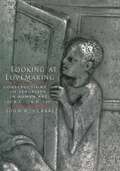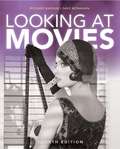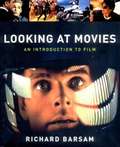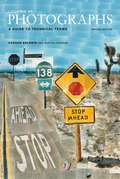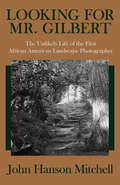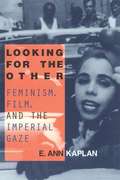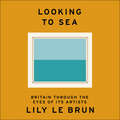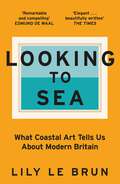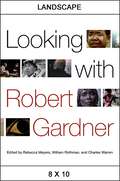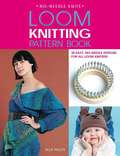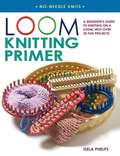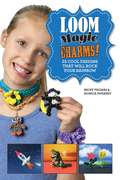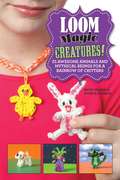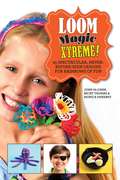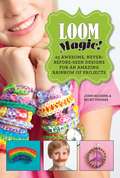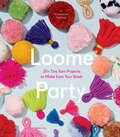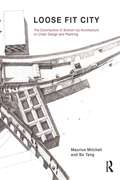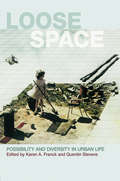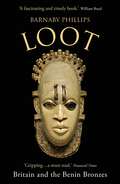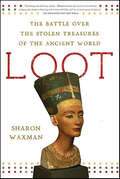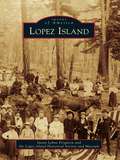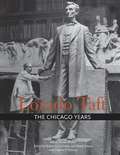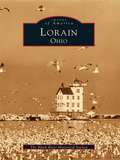- Table View
- List View
Looking at Lovemaking: Constructions of Sexuality in Roman Art, 100 B.C. – A.D. 250
by John R. ClarkeWhat did sex mean to the ancient Romans? In this lavishly illustrated study, John R. Clarke investigates a rich assortment of Roman erotic art to answer this question—and along the way, he reveals a society quite different from our own. Clarke reevaluates our understanding of Roman art and society in a study informed by recent gender and cultural studies, and focusing for the first time on attitudes toward the erotic among both the Roman non-elite and women. This splendid volume is the first study of erotic art and sexuality to set these works—many newly discovered and previously unpublished—in their ancient context and the first to define the differences between modern and ancient concepts of sexuality using clear visual evidence.Roman artists pictured a great range of human sexual activities—far beyond those mentioned in classical literature—including sex between men and women, men and men, women and women, men and boys, threesomes, foursomes, and more. Roman citizens paid artists to decorate expensive objects, such as silver and cameo glass, with scenes of lovemaking. Erotic works were created for and sold to a broad range of consumers, from the elite to the very poor, during a period spanning the first century B.C. through the mid-third century of our era. This erotic art was not hidden away, but was displayed proudly in homes as signs of wealth and luxury. In public spaces, artists often depicted outrageous sexual acrobatics to make people laugh.Looking at Lovemaking depicts a sophisticated, pre-Christian society that placed a high value on sexual pleasure and the art that represented it. Clarke shows how this culture evolved within religious, social, and legal frameworks that were vastly different from our own and contributes an original and controversial chapter to the history of human sexuality.
Looking at Movies: An Introduction to Film
by Richard Barsam Dave MonahanLooking at Movies is the most effective introduction to film analysis available. From its very first chapter, Looking at Movies provides students with the tools they need to become perceptive viewers of film. The Fourth Edition is not only more comprehensive, but also more accessible and sophisticated in its integration of media.
Looking at Movies: An Introduction to Film
by Richard BarsamIn using the work "looking" in the title of his introductory college-level film text, Barsam (emeritus, film studies, Hunter College) hopes to demonstrate that students need to actively examine relationships of form and content in cinema. Primarily focused on introducing film analysis, the text does include some discussion of film history, theory, and production.
Looking at Photographs: A Guide to Technical Terms
by Gordon Baldwin Martin JürgensFrom its origins at the end of the 1830s, photography has never ceased to evolve both aesthetically and technologically. The past decade has given rise to the new age of digital photography, so "Looking at Photographs," first published in 1991, has been revised and updated to define and illustrate terms from the earliest processes to this new technology. At once a rich and informative glossary and a history of the medium, this fully illustrated guide will be invaluable to all those wishing to increase their understanding and enjoyment of the art of photography. "
Looking at the Lights: My Path from Fan to a Wrestling Heel
by Adam Copeland Jon Robinson Pete Gas John LayfieldHow did an untrained former college football player end up in the middle of a ring, wrestling during the highest-rated segment during the WWE’s acclaimed Attitude Era?That’s the story behind Looking at the Lights. As a childhood friend of Shane McMahon, Pete Gas was given the opportunity most only pray for. Beginning with appearances to interfere in McMahon’s matches, his role blossomed into becoming a full-fledge wrestler and leading the Mean Street Posse to WrestleMania, becoming one of the most fascinating success stories of the era.From his humble upbringing and friendship with Shane (and the McMahon family as a whole), Gas shares how a 9-to-5 average Joe got the chance of a lifetime and made the most out of it.But getting your foot in the door is one thing; staying is a completely different animal. With all eyes on him, knowing his lack of training and meal ticket being the boss’s son, Gas knew he had to win over all those doubters: from the fans and announcers to the wrestlers themselves.Knowing he had to prove himself, Gas took beatings, chair shots, and additional training to not only show that he could wrestle, but that he belonged with such superstars as The Rock, "Stone Cold” Steve Austin, and The Undertaker.Featuring forewords by Edge and JBL, who famously nailed Gas in the head with a steel chair, readers will get an inside look into not only the training and sacrifice these athletes go through, but the behind-the-scenes workings of a day in the WWE.
Looking for Mr. Gilbert: The Unlikely Life of the First African American Landscape Photographer (History Ser.)
by John Hanson MitchellLooking for Mr. Gilbert is an account of the quest to uncover the heretofore unknown life of Robert A. Gilbert, an African American serving man who worked for the ornithologist William Brewster. A man of many talents, Gilbert went on to become the first African American landscape photographer.
Looking for the Other: Feminism, Film and the Imperial Gaze
by E. Ann KaplanWhat happens when white people look at non-whites? What happens when the gaze is returned? Looking for the Other responds to criticisms leveled at white feminist film theory of the 1970s and 1980s for its neglect of issues to do with race. It focuses attention on the male gaze across cultures, as illustrated by women filmmakers of color whose films deal with travel. Looking relations are determined by history, tradition, myth; by national identity, power hierarchies, politics, economics, geographical and other environment. Travel implicitly involves looking at, and looking relations with, peoples different from oneself. Featured films include Birth of a Nation, The Cat People, Home of the Brave, Black Narcissus, Chocolat, and Warrior Marks. Featured filmmakers include D.W.Griffith, Jacques Tourneur, Michael Powell, Julie Dash, Pratibha Parmar, Trinh T. Min-ha, and Claire Denis.
Looking to Sea: Britain Through the Eyes of its Artists
by Lily Le BrunLooking to Sea is an alternative history of Britain in the twentieth century, told through the prism of ten iconic artworks of the sea, one for each decade.'We see nothing truly until we understand it.' John ConstableAn alternative history of Britain in the twentieth century, Looking to Sea is an exquisite work of cultural, artistic and philosophical history.From Vanessa Bell's Studland Beach, one of the first modernist paintings in Britain, to Paul Nash's work bearing the scars of his experience in the trenches and Martin Parr's photographs of seaside resorts in the 1980s that tackle ideas of class and deprivation, Looking to Sea embraces ideas from modernism and the sublime, the impact of the world wars and colonialism, to issues crucial to our world today like the environment and nationhood.Looking to Sea is an astonishingly perceptive portrait of the twentieth century. Art critic Lily Le Brun brings a fresh eye, acute observation and challenges the reader to find a new way to look at the history of our island nation.'Looking to Sea is a remarkable and compelling book. It is both a wonderfully sustained mapping of the intersection between artists, writers and the sea and a meditation on belonging and displacement. I loved it.' Edmund de Waal(P) 2022 Hodder & Stoughton Limited
Looking to Sea: Britain Through the Eyes of its Artists
by Lily Le Brun*One of The Times Best Art Books of the Year*'Looking to Sea is a remarkable and compelling book... I loved it.' Edmund de Waal'In her first, transporting book, Lily Le Brun sweeps the beaches of the past century of British art, collecting treasures from sea, shingle and shore... A book to pack in your picnic basket for shivering dips, heatwave day trips and ice-cream Sundays' The TimesAn alternative history of modern Britain, Looking to Sea is an exquisite work of cultural, artistic and philosophical storytelling. Looking to Sea considers ten pivotal artworks, from Vanessa Bell's Studland Beach, one of the first modernist paintings in Britain, to Paul Nash's work bearing the scars of his experience in the trenches and Martin Parr's photographs of seaside resorts in the 1980s, which raised controversial questions of class. Each of the startlingly different pieces, created between 1912 and 2015, opens a window onto big ideas, from modernism and the sublime, the impact of the world wars and colonialism, to issues crucial to our world today like the environment and nationhood. In this astonishingly perceptive portrait of the twentieth century, art critic Lily Le Brun brings a fresh eye to a vast idea, offering readers an imaginative new way of seeing our island nation.'Le Brun's writing is at once bold and delicate, far-reaching and fine-tuned. Her book explores the inexhaustible variety of human perception.' Alexandra Harris'A smart and clear-eyed set of meditations on marine gaze, made with a painterly touch worthy of the chosen artists. Empathy and intelligence lift memoir into cultural history.' Iain Sinclair'Elegant and endlessly interesting . . . as much a rich compendium of social history as it is a hard consideration of art itself' Critic
Looking with Robert Gardner (SUNY series, Horizons of Cinema)
by Rebecca Meyers; William Rothman; Charles WarrenDuring his lifetime, Robert Gardner (1925–2014) was often pigeonholed as an ethnographic filmmaker, then criticized for failing to conform to the genre's conventions—conventions he radically challenged. With the release of his groundbreaking film Dead Birds in 1963, Gardner established himself as one of the world's most extraordinary independent filmmakers, working in a unique border area between ethnography, the essay film, and poetic/experimental cinema. Richly illustrated, Looking with Robert Gardner assesses the range and magnitude of Gardner's achievements not only as a filmmaker but also as a still photographer, writer, educator, and champion of independent cinema. The contributors give critical attention to Gardner's most ambitious films, such as Dead Birds (1963, New Guinea), Rivers of Sand (1975, Ethiopia), and Forest of Bliss (1986, India), as well as lesser-known films that equally exemplify his mode of seeking anthropological understanding through artistic means. They also attend to his films about artists, including his self-depiction in Still Journey OnM (2011); to his roots in experimental film and his employment of experimental procedures; and to his support of independent filmmakers through the Harvard Film Study Center and the television series Screening Room, which provided an opportunity for numerous important film and video artists to present and discuss their work.
Loom Knitting Pattern Book
by Isela PhelpsFor all those who have struggled to knit with needles, loom knitting is an easy craft to master--in only a few hours even the novice knitter can create fabulous accessories, clothes, bags, afghans, and more. Loom knitting is a revolutionary way of knitting that uses a circular or rectangular loom, or a knitting board, consisting of a frame with pegs. Looms are fun and easy to use, even for those with no knitting experience. In her follow-up to the successful LOOM KNITTING PRIMER, Isela offers over 32 projects ranging from simple to advanced, each with illustrations and crystal clear, easy-to-follow instructions. Learn how to make more original, beautiful, and practical items quickly and easily. An essential resource for both the novice loom-knitter and the experienced knitter hungry for new patterns.
Loom Knitting Primer
by Isela PhelpsFrom the Book jacket: If you have struggled to knit with needles, loom knitting is an easy craft to master-children and adults alike can learn in a few hours. Loom knitting is a revolutionary way of knitting that uses a circular or rectangular loom, or knitting board, consisting of a frame with pegs. Looms are easy and fun to use, even without conventional knitting experience. You can create almost anything, from knitted tubes for hats or socks to flat panels for scarves, shawls, and sweaters. This book is designed as an essential reference and a hands-on project resource for the loom knitter. Throughout the book you will find loom-knitting techniques for both round and rectangular looms, together with practice projects. An inspiring design section presents more than 30 patterns to get you started in your new loom-knitting adventure. Also included is a guide to the similarities between loom knitting and needle knitting, and a glossary of techniques. Everything you need to master loom knitting quickly and easily, from technical know-how to instantly appealing designs. An essential loom-knitting manual to supplement the often scant instructions supplied with the looms. More than 30 nifty, no-needle, quick-and-easy patterns for sweaters and accessories, including projects to felt. About the Author: Isela Phelps is a graduate of Utah State University where she received a degree in business administration. She is part of the Decor Accents, Inc. team, a manufacturer of knitting looms. Isela also teaches knitting loom classes at Yarn Today, a Utah yarn store, and owns and moderates two knitting loom online community groups. Isela has been loom knitting for five years, during which time she has created instructions, patterns, and visual aids to teach others her art. She also maintains a loom-knitting website.
Loom Magic Charms!: 25 Cool Designs That Will Rock Your Rainbow
by Becky Thomas Monica Sweeney Neary AlguardRainbow Looms have taken the world by storm! With projects of every variety, from bracelets, rings, and necklaces, to sports fan memorabilia, to cute little critters, there is a fun creation for every loomer out there.<P><P>As loomers get more skilled, they are looking to go beyond bracelets-and charms are where it's at! These little decorations can adorn bracelets, necklaces, or even shoelaces and zippers. And each project only needs one loom! This book will offer twenty-five original designs for all kinds of charms to make with Rainbow Looms, including:T-RexTop hatMonkeySunflowerDollar signAppleTreble ClefBananaFoxOwlFlip flopsRocketDolphinTulipLock and KeySunglassesAnd many more!Tired of the same old projects? Loom Magic Charms! will help you add that extra something to your Rainbow Loom designs!
Loom Magic Creatures!: 25 Awesome Animals and Mythical Beings for a Rainbow of Critters
by Becky Thomas Monica SweeneyFrom the authors of bestselling titles Loom Magic! and Loom Magic Xtreme! comes Loom Magic Creatures!: 25 Awesome Animals and Mythical Beings for a Rainbow of Critters. <P><P>According to the New York Times, Rainbow Looms are the hottest trend on the market, and it is continuously growing in popularity. New and crazy designs are being created every day, and now you can astound all of your friends with these fun and wacky critters, including:MedusaButterflyPenguinCrabDogBunnySpiderPigGingerbread manParrotDragonPrincessSantaRobotCatAnd many more!This collection of never-before-seen projects will have all of your friends begging for your Rainbow Loom secrets!
Loom Magic Xtreme!: 25 Spectacular, Never-Before-Seen Designs for Rainbows of Fun
by Becky Thomas John Mccann Monica SweeneyFrom the authors of the instant bestseller Loom Magic! comes a second amazing project book with twenty-five totally new and extreme designs!<P><P> Rainbow Looms are taking the world by storm, with devotees of all ages accessorizing their wrists, backpacks, and rooms with fun and creative projects.These super imaginative, out-of-this-world projects will take your rubber band loom projects to the next level. Here are kid-tested step-by-step instructions and bright color photographs to show you how to make the coolest rubber band projects out there, including:Twisty headbandBouquet of flowersOctopusDecorated ponytail holderFashion jewelry standGlow-in-the-dark starsZipper decorationHockey stickBloodshot eyeballsBlack batAnd many more!
Loom Magic!: 25 Awesome, Never-Before-Seen Designs for an Amazing Rainbow of Projects
by Becky Thomas John MccannThis book includes twenty-five new rubber band loom projects, including bracelets, sports-themed charms, key rings, pendants, and even a working slingshot. <P><P>New crafters and dedicated fans will enjoy creating the wide variety of projects in this collection, including:Cell phone caseDaisy chain braceletWatch bandOcto braceletBlooming beaded braceletSports fan keychainMatching barrettesPencil topperRainbow ringNunchuksRocker cuff braceletSnowman ornamentAnd many more!
Loome Party: 20+ Tiny Yarn Projects to Make from Your Stash
by Vilasinee BunnagBigger isn’t better—especially with the versatile Loome tool! Make pom-poms, tassels, jewelry and many more small and splendid projects. Loome Party is a one-stop shop for learning how to use the Loome tool to make projects using only your yarn stash. Learn the foundations of creating pom-poms, tassels, friendship bracelets, weavings, and cords galore with Vilasinee Bunnag, founder of Loome. Bunnag provides clear, step-by-step instructions and colorful photography that will teach you how to use the all-in-one tool to make mini masterpieces. Once you’ve got the hang of working with the tool, you’ll learn how to change and combine these basic elements to make more than 20 bright and playful projects—each developed by a guest designer—including pom-pom gift toppers, woven bracelets, and tassel garlands. Loome Party is a fun, thorough, and modern reference full of approachable how-to projects for readers of all ages.
Loose Fit City: The Contribution of Bottom-Up Architecture to Urban Design and Planning
by Maurice Mitchell Bo TangDrawn from a lifetime’s experience of shared city-making from the bottom up, within rapidly expanding urban metabolisms in Delhi, Mumbai, Agra, Kathmandu, West Africa and London, Loose Fit City is about the ways in which city residents can learn through making to engage with the dynamic process of creating their own city. It looks at the nature and processes involved in loosely fitting together elements made by different people at different scales and times, with different intentions, into a civic entity which is greater than the sum of its parts. It shows how bottom-up learning through making can create a more vibrant and democratic city than the more flattened, top-down, centrally planned, factory made version. Loose Fit City provides a new take on the subject of architecture, defined as the study and practice of fitting together physical and cultural topography. It provides a comprehensive view of how the fourth dimension of time fits loosely together with the three spatial dimensions at different scales within the human horizon, so as to layer meaning and depth within the places and metabolism of the city fabric.
Loose Space: Possibility and Diversity in Urban Life
by Karen A. Franck Quentin StevensIn cities around the world people use a variety of public spaces to relax, to protest, to buy and sell, to experiment and to celebrate. Loose Space explores the many ways that urban residents, with creativity and determination, appropriate public space to meet their own needs and desires. Familiar or unexpected, spontaneous or planned, momentary or long-lasting, the activities that make urban space loose continue to give cities life and vitality. The book examines physical spaces and how people use them. Contributors discuss a wide range of recreational, commercial and political activities; some are conventional, others are more experimental. Some of the activities occur alongside the intended uses of planned public spaces, such as sidewalks and plazas; other activities replace former uses, as in abandoned warehouses and industrial sites. The thirteen case studies, international in scope, demonstrate the continuing richness of urban public life that is created and sustained by urbanites themselves Presents a fresh way of looking at urban public space, focusing on its positive uses and aspects. Comprises 13 detailed, well-illustrated case studies based on sustained observation and research by social scientists, architects and urban designers. Looks at a range of activities, both everyday occurrences and more unusual uses, in a variety of public spaces -- planned, leftover and abandoned. Explores the spatial and the behavioral; considers the wider historical and social context. Addresses issues of urban research, architecture, urban design and planning. Takes a broad international perspective with cases from New York, London, Berlin, Amsterdam, Rome, Guadalajara, Athens, Tel Aviv, Melbourne, Bangkok, Kandy, Buffalo, and the North of England.
Loose and Lively Animals in Watercolour, Inks & Mixed Media
by Jo AllsoppAnimals are a perennial favourite amongst artists, but many struggle with capturing their form and character in a way that reflects the true spirit of the animal. In this bright, breezy and accessible book, Jo Allsopp’s genuine passion for wildlife is clear. That love is reflected in her art, and her loose, lively and dynamic style is one that many wish to emulate.Including a broad range of animals from around the world – everything from red squirrels to peacocks, lions and housecats – this book will inspire and instruct beginner artists, appeal to animal-loving hobby artists, and provide new ideas for more advanced artists who wish to loosen up their style and take a more experimental approach to their watercolour painting. It includes:A section exploring inspiration and motivationShort practical exercises to help you loosen up and try things outA close look at Jo's way of painting, which demystifies the process and includes drawing techniques3 pure watercolour projects and 9 incorporating mixed mediaFully illustrated projects that are explained step-by-step, showing you how to personalise your pictures.Jo's technique is very wet into wet, with lots of blooms, vivid colours, and striking contrasts and texture achieved by the addition of wax resist, salt, spatter and scratching out.Jo uses an exciting range of art media and techniques in her work. The main medium is watercolour, but to this she adds ink, water-soluble and permanent pens; bleach; isopropyl alcohol; bronzing powders; metallic leaf and acrylic inks. All are explored and explained to show the effects that can be achieved and when and how to use them.
Loot: Britain and the Benin Bronzes (Modern Classics Ser.)
by Barnaby Phillips&‘A fascinating and timely book.&’ William Boyd &‘Gripping…a must read.&’ FT In 1897, Britain responded to the killing of a group of officials by razing an empire to the ground. The men had been travelling to the ancient Kingdom of Benin, in what is now Nigeria, when they were ambushed and killed by local soldiers. Just six weeks later, the British had exacted their revenge, set Benin aflame, exiled the king and annexed the territory. They also made off with some of Africa&’s greatest works of art.This is the story of the &‘Benin Bronzes&’, their creation, removal, and what should happen to them now. When first exhibited in London they caused a sensation and helped reshape European attitudes towards Africa, challenging the prevailing view of the continent as &‘backward&’ and without culture. But seeing them in the British Museum today is, in the words of one Benin City artist, like &‘visiting relatives behind bars&’. In a time of fevered debate about the legacies of empire, loot, museums and history, what does the future hold for the Bronzes themselves?
Loot: The Battle Over the Stolen Treasures of the Ancient World
by Sharon WaxmanA journey across four continents to the heart of the conflict over who should own the great works of ancient artWhy are the Elgin Marbles in London and not on the Acropolis? Why do there seem to be as many mummies in France as there are in Egypt? Why are so many Etruscan masterworks in America? For the past two centuries, the West has been plundering the treasures of the ancient world to fill its great museums, but in recent years, the countries where ancient civilizations originated have begun to push back, taking museums to court, prosecuting curators, and threatening to force the return of these priceless objects.Where do these treasures rightly belong? Sharon Waxman, a former culture reporter for The New York Times and a longtime foreign correspondent, brings us inside this high-stakes conflict, examining the implications for the preservation of the objects themselves and for how we understand our shared cultural heritage. Her journey takes readers from the great cities of Europe and America to Egypt, Turkey, Greece, and Italy, as these countries face down the Louvre, the Metropolitan Museum, the British Museum, and the J. Paul Getty Museum. She also introduces a cast of determined and implacable characters whose battles may strip these museums of some of their most cherished treasures.For readers who are fascinated by antiquity, who love to frequent museums, and who believe in the value of cultural exchange, Loot opens a new window on an enduring conflict.
Lopez Island
by Lopez Island Historical Society and Museum Susan Lehne FergusonThe story of Lopez Island is a story of community. Skilled, brave, generous people like Sampson Chadwick, Mother Brown, Captain Barlow, and Amelia Davis carved a spirited, nurturing community out of seaside wilderness. Homesteaders cleared forests, built farms, grew food, and raised large families, surviving then thriving together. The hamlets of Port Stanley, Richardson, and Lopez emerged, creating hubs with stores, post offices, and schools as well as thriving fishing, canning, and shipping industries. The community fostered education, music, writing, dances, chivarees, baseball, quilting, a birthday club, and grand Fourth of July celebrations. Living self-reliant lives while helping friends, neighbors, and newcomers, Lopezians created a unique community character that abides today.
Lorado Taft: The Chicago Years
by Henry Adams Robert G. La France Allen Stuart WellerSculptor Lorado Taft helped build Chicago's worldwide reputation as the epicenter of the City Beautiful Movement. In this new biography, art historian Allen Stuart Weller picks up where his earlier book Lorado in Paris left off, drawing on the sculptor's papers to generate a fascinating account of the most productive and influential years of Taft's long career. Returning to Chicago from France, Taft established a bustling studio and began a twenty-one-year career as an instructor at the Art Institute, succeeded by three decades as head of the Midway Studios at the University of Chicago. This triumphant era included: ephemeral sculpture for the 1893 World's Columbian Exposition; a prolific turn-of-the-century period marked by the gold-medal-winning The Solitude of the Soul; the 1913 Fountain of the Great Lakes; the 1929 Alma Mater at the University of Illinois; and large-scale projects such as his ambitious program for Chicago's Midway with the monumental Fountain of Time. In addition, the book charts Taft's mentoring of women artists, including the so-called White Rabbits at the World's Fair, many of whom went on to achieve artistic success. Lavishly illustrated with color images of Taft's most celebrated works, Lorado Taft: The Chicago Years completes the first major study of a great American artist.
Lorain (Images of America)
by The Black River Historical SocietyThe City of Lorain was incorporated in 1874 by the town council. It was named after the county, which had been named by Heman Ely, who thought the area looked very much like the Province of Lorraine in France. Lorainâ TMs location next to Lake Erie and theearly arrival of the B&O Railroad in 1871 made thecity a hotbed for industry. The Hayden Brass Worksbuilt a large plant on Elyria Avenue. Captain Thew, aship captain on the lakes, developed an improved gearsystem for a steam shovel, and that started the Lorain Thew Shovel Co., which became known worldwide.Lorain grew tremendously in the 1890s. Constructionof the Johnson Steel Rail Company started in 1894, and in just ten years, the population of the City of Lorain tripled. In 1894, the American Stove Works built a plant in Lorain, where they made heaters and furnaces. Three years later, the American Shipbuilding Company built a yard and launched hundreds of ships before it closed in 1984. Lorain, Ohio, certainly did its part during World War II; many men went into service, and Lorain produced its own share of heroes. The shipyard was also put to work by the government to build the USS Lorain, a frigate.
